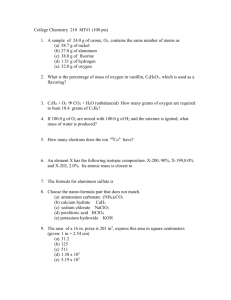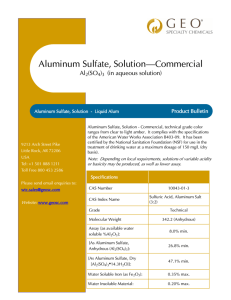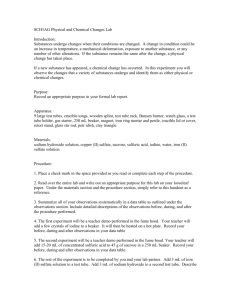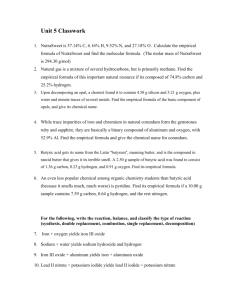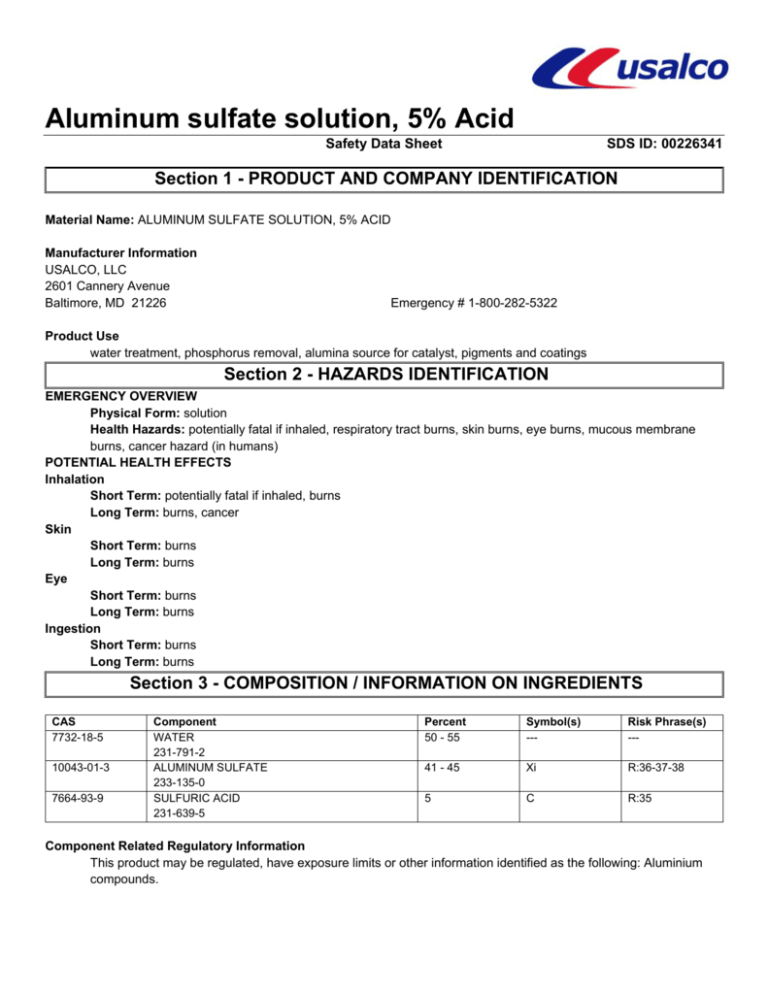
Aluminum sulfate solution, 5% Acid
Safety Data Sheet
SDS ID: 00226341
Section 1 - PRODUCT AND COMPANY IDENTIFICATION
Material Name: ALUMINUM SULFATE SOLUTION, 5% ACID
Manufacturer Information
USALCO, LLC
2601 Cannery Avenue
Baltimore, MD 21226
Emergency # 1-800-282-5322
Product Use
water treatment, phosphorus removal, alumina source for catalyst, pigments and coatings
Section 2 - HAZARDS IDENTIFICATION
EMERGENCY OVERVIEW
Physical Form: solution
Health Hazards: potentially fatal if inhaled, respiratory tract burns, skin burns, eye burns, mucous membrane
burns, cancer hazard (in humans)
POTENTIAL HEALTH EFFECTS
Inhalation
Short Term: potentially fatal if inhaled, burns
Long Term: burns, cancer
Skin
Short Term: burns
Long Term: burns
Eye
Short Term: burns
Long Term: burns
Ingestion
Short Term: burns
Long Term: burns
Section 3 - COMPOSITION / INFORMATION ON INGREDIENTS
CAS
7732-18-5
10043-01-3
7664-93-9
Component
WATER
231-791-2
ALUMINUM SULFATE
233-135-0
SULFURIC ACID
231-639-5
Percent
50 - 55
Symbol(s)
---
Risk Phrase(s)
---
41 - 45
Xi
R:36-37-38
5
C
R:35
Component Related Regulatory Information
This product may be regulated, have exposure limits or other information identified as the following: Aluminium
compounds.
Aluminum sulfate solution 5% Acid
Safety Data Sheet
SDS ID: 00226341
Section 4 - FIRST AID MEASURES
Inhalation
If adverse effects occur, remove to uncontaminated area. Give artificial respiration if not breathing. If breathing is
difficult, oxygen should be administered by qualified personnel. Get immediate medical attention.
Skin
Wash skin with soap and water for at least 15 minutes while removing contaminated clothing and shoes. Get
immediate medical attention. Thoroughly clean and dry contaminated clothing before reuse. Destroy
contaminated shoes.
Eyes
Immediately flush eyes with plenty of water for at least 15 minutes. Then get immediate medical attention.
Ingestion
If swallowed, drink plenty of water, do NOT induce vomiting. Get immediate medical attention.
Note to Physicians
For inhalation, consider oxygen.
Avoid gastric lavage or emesis.
Section 5 - FIRE FIGHTING MEASURES
See Section 9 for Flammability Properties
NFPA Ratings: Health: 3 Fire: 0 Reactivity: 0
Hazard Scale: 0 = Minimal 1 = Slight 2 = Moderate 3 = Serious 4 = Severe
Flammable Properties
Negligible fire hazard.
Extinguishing Media
carbon dioxide, regular dry chemical, regular foam, water
Fire Fighting Measures
Move container from fire area if it can be done without risk. Cool containers with water spray until well after the
fire is out. Do not get water directly on material. Avoid inhalation of material or combustion by-products. Stay
upwind and keep out of low areas.
Thermal Decomposition Products
Combustion: oxides of sulfur
Sensitivity to Mechanical Impact
Not sensitive
Sensitivity to Static Discharge
Not sensitive
Section 6 - ACCIDENTAL RELEASE MEASURES
Soil Release
Dig holding area such as lagoon, pond or pit for containment. Dike for later disposal. Absorb with sand or other
non-combustible material.
Water Release
Subject to California Safe Drinking Water and Toxic Enforcement Act of 1986 (Proposition 65). Keep out of water
supplies and sewers. Add an alkaline material (lime, crushed limestone, sodium bicarbonate, or soda ash).
Collect spilled material using mechanical equipment.
____________________________________________________________
Page 2 of 12
Issue Date: 12/15/2011
Revision: 1.0610
Print Date: 5/1/2013
Aluminum sulfate solution 5% Acid
Safety Data Sheet
SDS ID: 00226341
Occupational spill/release
Do not touch spilled material. Stop leak if possible without personal risk. Small spills: Absorb with sand or other
non-combustible material. Small dry spills: Collect spilled material in appropriate container for disposal. Keep
unnecessary people away, isolate hazard area and deny entry. Notify Local Emergency Planning Committee and
State Emergency Response Commission for release greater than or equal to RQ (U.S. SARA Section 304). If
release occurs in the U.S. and is reportable under CERCLA Section 103, notify the National Response Center at
(800)424-8802 (USA) or (202)426-2675 (USA).
Section 7 - HANDLING AND STORAGE
Handling Procedures
Handle as a corrosive liquid. When mixing, slowly add to water to minimize heat generation and spattering. Keep
emergency spill kit near storage and use areas.
Storage Procedures
Store and handle in accordance with all current regulations and standards. Notify State Emergency Response
Commission for storage or use at amounts greater than or equal to the TPQ (U.S. EPA SARA Section 302).
SARA Section 303 requires facilities storing a material with a TPQ to participate in local emergency response
planning (U.S. EPA 40 CFR 355 Part B). Store with acids. See original container for storage recommendations.
Keep separated from incompatible substances.
Section 8 - EXPOSURE CONTROLS / PERSONAL PROTECTION
Component Exposure Limits
SULFURIC ACID (7664-93-9)
ACGIH: 0.2 mg/m3 TWA (thoracic fraction)
Ventilation
Provide local exhaust or process enclosure ventilation system. Ensure compliance with applicable exposure
limits.
PERSONAL PROTECTIVE EQUIPMENT
Eyes/Face
Wear splash resistant safety goggles with a faceshield. Provide an emergency eye wash fountain and quick
drench shower in the immediate work area.
Protective Clothing
Wear appropriate chemical resistant clothing.
Glove Recommendations
Wear appropriate chemical resistant gloves.
Respiratory Protection
Under conditions of frequent use or heavy exposure, respiratory protection may be needed.
Respiratory protection is ranked in order from minimum to maximum.
Consider warning properties before use.
Any air-purifying full-facepiece respirator equipped with an N95, R95, or P95 filter. The following filters may also
be used: N99, R99, P99, N100, R100 or P100.
Any powered, air-purifying respirator with a tight-fitting facepiece and a high-efficiency particulate filter.
Any supplied-air respirator with a full facepiece that is operated in a pressure-demand or other positive-pressure
mode.
For Unknown Concentrations or Immediately Dangerous to Life or Health Any supplied-air respirator with a full facepiece that is operated in a pressure-demand or other positive-pressure
mode in combination with an auxiliary self-contained breathing apparatus operated in pressure-demand or other
positive-pressure mode.
____________________________________________________________
Page 3 of 12
Issue Date: 12/15/2011
Revision: 1.0610
Print Date: 5/1/2013
Aluminum sulfate solution 5% Acid
Safety Data Sheet
SDS ID: 00226341
Any self-contained breathing apparatus that has a full facepiece and is operated in a pressure-demand or other
positive-pressure mode.
Section 9 - PHYSICAL AND CHEMICAL PROPERTIES
Physical State:
Physical Form:
Odor Threshold:
pH (solution):
Boiling Point:
Evaporation Rate:
Vapor Density (air = 1):
Specific Gravity (water = 1):
Coeff. Water/Oil Dist:
Volatility:
Liquid
solution
Not available
50 %
Not available
Not available
Not available
Not available
Not available
Not available
Appearance:
Odor:
pH:
Melting Point:
Flash Point:
Vapor Pressure:
Density:
Water Solubility:
Viscosity:
Not available
Not Available
1.6 - 2.2 approximate
Not available
aqueous solution
Not available
Not available
soluble
Not available
Section 10 - STABILITY AND REACTIVITY
Chemical Stability
Stable at normal temperatures and pressure.
Conditions to Avoid
Avoid heat, flames, sparks and other sources of ignition. May ignite or explode on contact with combustible
materials.
Materials to Avoid
bases, metals, combustible materials, halo carbons, oxidizing materials, amines, halogens, metal carbide, acids,
metal salts, peroxides, reducing agents
SULFURIC ACID:
ACETALDEHYDE: Violently polymerized by concentrated acid.
ACETIC ANHYDRIDE: Temperature and pressure increase in closed container.
ACETONE + NITRIC ACID: Violent decomposition.
ACETONE + POTASSIUM DICHROMATE: Ignition.
ACETONE CYANHYDRIN: Pressure increase with possible explosive rupture of vessel.
ACETONITRILE: Violent exotherm on heating; sulfur trioxide reduces initiation temperature.
ACROLEIN: Temperature and pressure increase in closed container.
ACRYLONITRILE: Vigorous exothermic polymerization.
ALCOHOL: Exothermic reaction and contraction of volume.
ALCOHOLS AND HYDROGEN PEROXIDE: Possible explosion.
ALLYL ALCOHOL: Temperature and pressure increase in closed container.
ALLYL CHLORIDE: Violent polymerization.
ALKYL NITRATES: May cause violent reaction.
2-AMINOETHANOL: Temperature and pressure increase in closed container.
AMMONIUM HYDROXIDE: Temperature and pressure increase in closed container.
AMMONIUM IRON(III) SULFATE DODECAHYDRATE: Violent, exothermic reaction on heating.
AMMONIUM TRIPERCHROMATE: Fire or explosion hazard.
ANILINE: Temperature and pressure increase in closed container.
BASES: Violent reaction.
BENZYL ALCOHOL: May decomposes explosively at about 180 C.
BROMATES + METALS: Possible ignition.
____________________________________________________________
Page 4 of 12
Issue Date: 12/15/2011
Revision: 1.0610
Print Date: 5/1/2013
Aluminum sulfate solution 5% Acid
Safety Data Sheet
SDS ID: 00226341
BROMINE PENTAFLUORIDE: Violent reaction with possible ignition.
TERT-BUTYL-M-XYLENE: Violent exothermic reaction without agitation.
N-BUTYRALDEHYDE: Temperature and pressure increase in closed container.
CARBIDES: Hazardous mixture.
CESIUM ACETYLIDE: Ignition on contact.
1-CHLORO-2,3-EPOXYPROPANE: Violent interaction.
4-CHLORONITROBENZENE AND SULFUR TRIOXIDE: Possible explosive reaction.
CHLORATES: All chlorates, when brought in contact with sulfuric acid may give
off explosive chlorine dioxide gas. A violent explosion is usual.
CHLORATES + METALS: Possible ignition.
CHLORINE TRIFLUORIDE: Violent reaction.
CHLOROSULFONIC ACID: Temperature and pressure increase in closed container.
CHROMATES: Fire and explosion hazard.
COATINGS: Attacked.
COMBUSTIBLE MATERIALS (FINELY DIVIDED): May ignite.
COPPER: Evolution of sulfur dioxide.
CUPROUS NITRIDE: Violent reaction.
2-CYANO-4-NITROBENZENEDIAZONIUM HYDROGEN SULFATE: Exothermic reaction.
2-CYANO-2-PROPANOL: Violent reaction with increase in pressure.
CYCLOPENTADIENE: Violent or explosive reaction.
CYCLOPENTANONE OXIME: Violent reaction.
1,3-DIAZIDOBENZENE: Ignition followed by explosive reaction.
DIETHYLAMINE: Exothermic reaction.
DIISOBUTYLENE: Temperature and pressure increase in closed container.
DIMETHYLBENZYLCARBINOL + HYDROGEN PEROXIDE: Explodes.
DIMETHOXYANTHRAQUINONE: Exothermic reaction above 150 C.
4-DIMETHYLAMINOBENZALDEHYDE: Exothermic reaction.
2,5-DINITRO-3-METHYLBENZOIC ACID + SODIUM AZIDE: Explosive reaction.
1,5-DINITRONAPHTHALENE + SULFUR: Exothermic reaction.
EPICHLOROHYDRIN: Violent reaction.
ETHOXYLATED NONYLPHENOL: Possible ignition.
ETHANOL + HYDROGEN PEROXIDE: Possible explosion.
ETHYLENE CYANOHYDRIN: Violent reaction.
ETHYLENE DIAMINE: Temperature and pressure increase in closed container.
ETHYLENE GLYCOL: Temperature and pressure increase in closed container.
ETHYLENIMINE: Temperature and pressure increase in closed container.
FULMINATES: Extremely hazardous mixture.
HEXALITHIUM DISILICIDE: Incandescent reaction.
HYDROCHLORIC ACID: Temperature and pressure increase in closed container.
HYDROGEN PEROXIDE (>50%): Explosive reaction after evaporation.
HYDROFLUORIC ACID: Temperature and pressure increase in closed container.
INDANE + NITRIC ACID: Possible explosion.
IODINE HEPTAFLUORIDE: The acid becomes effervescent.
IRON: Possible explosion due to hydrogen gas from the acid-metal reaction.
ISOPRENE: Temperature and pressure increase in closed container.
LITHIUM SILICIDE: Incandescent reaction.
____________________________________________________________
Page 5 of 12
Issue Date: 12/15/2011
Revision: 1.0610
Print Date: 5/1/2013
Aluminum sulfate solution 5% Acid
Safety Data Sheet
SDS ID: 00226341
MERCURY NITRIDE: Explosion on contact.
MESITYL OXIDE: Temperature and pressure increase in closed container.
METALS: May liberate flammable hydrogen gas.
METALS (POWDERED): Extremely hazardous mixture.
METAL ACETYLIDES: Ignition reaction.
METAL CHLORATES: Violent explosion unless properly cooled.
METAL PERCHLORATES: Formation of explosive perchloric acid.
4-METHYLPYRIDINE: Exothermic reaction.
NITRAMIDE: May decompose explosively on contact.
NITRATES: Incompatible.
NITRIC ACID + GLYCERIDES: Explosion.
NITRIC ACID + ORGANIC MATERIAL: May cause violent reaction.
NITRIC ACID + TOLUENE: Possible violent reaction or explosion.
NITROARYL BASES AND DERIVATIVES: May cause violent reaction or explosion.
NITROBENZENE: Exothermic reaction at elevated temperatures.
3-NITROBENZENESULFONIC ACID: Exothermic reaction.
NITROMETHANE: Formation of explosive mixture.
N-NITROMETHYLAMINE: Explosive decomposition.
4-NITROTOLUENE: Explosive at 80 C.
ORGANICS: Violent exothermic reaction.
PENTASILVER TRIHYDROXYDIAMIDOPHOSPHATE: Explosion on contact.
PERCHLORATES: Possible explosion.
PERCHLORIC ACID: Formation of dangerous anhydrous perchloric acid.
PERMANGANATES: Formation of permanganic acid.
PERMANGANATES + BENZENE: Possible explosion.
1-PHENYL-2-METHYL-PROPYL ALCOHOL + HYDROGEN PEROXIDE: Possible explosion.
PHOSPHORUS (WHITE OR YELLOW): Ignition in contact with boiling acid.
PHOSPHORUS ISOCYANATE: Violent reaction.
PHOSPHORUS TRIOXIDE: Violent oxidation with possible ignition.
PICRATES: Extremely hazardous mixture.
PLASTICS: Attacked.
POLYSILYLENE: Explosion on contact.
POTASSIUM: Explosive interaction.
POTASSIUM TERT-BUTOXIDE: Ignition.
POTASSIUM CHLORATE: Possible fire and explosion.
POTASSIUM PERMANGANATE: Possible explosion in the presence of moisture.
POTASSIUM PERMANGANATE + POTASSIUM CHLORIDE: Violent explosion.
PROPIOLACTONE (BETA): Temperature and pressure increase in closed container.
PROPYLENE OXIDE: Temperature and pressure increase in closed container.
3-PROPYNOL: Possible explosion unless adequately cooled.
PYRIDINE: Temperature and pressure increase in closed container.
REDUCING AGENTS: Reacts.
RUBBER: Attacked.
RUBIDIUM ACETYLIDE: Ignition on contact.
SILVER PERMANGANATE (MOIST): Explosive reaction.
SILVER PEROXOCHROMATE: Explosive reaction.
____________________________________________________________
Page 6 of 12
Issue Date: 12/15/2011
Revision: 1.0610
Print Date: 5/1/2013
Aluminum sulfate solution 5% Acid
Safety Data Sheet
SDS ID: 00226341
SODIUM: Explosive reaction with aqueous acid.
SODIUM CARBONATE: Violent reaction.
SODIUM CHLORATE: Possible fire or explosion.
SODIUM HYDROXIDE: Temperature and pressure increase in closed container.
SODIUM TETRAHYDROBORATE: Violent, exothermic reaction.
SODIUM THIOCYANATE: Violent exothermic with evolution of carbonyl sulfide.
STEEL: Possible explosion due to hydrogen gas from the acid-metal reaction.
STYRENE MONOMER: Temperature and pressure increase in closed container.
SUCROSE: Formation of carbon monoxide.
TETRAMETHYLBENZENES: Violent reaction in closed containers.
1,2,4,5-TETRAZINE: Violent decomposition on contact.
THALLIUM(I) AZIDIDITHIOCARBONATE: May explode on contact.
1,3,5-TRINITROSOHEXAHYDRO-1,3,5-TRIAZINE: Explosive decomposition on contact.
VINYL ACETATE: Temperature and pressure increase in closed container.
ZINC CHLORATE: Likely to cause fires and explosions.
ZINC IODIDE: Violent interaction.
ALUMINUM SULFATE:
BASES: Violent reaction.
METALS: May be corrosive in the presence of moisture.
Thermal Decomposition Products
Combustion: oxides of sulfur
Possibility of Hazardous Reactions
Will not polymerize.
Section 11 - TOXICOLOGICAL INFORMATION
Component Analysis - LD50/LC50
The components of this material have been reviewed in various sources and the following selected endpoints are
published:
WATER (7732-18-5)
Oral LD50 Rat >90 mL/kg
ALUMINUM SULFATE (10043-01-3)
Oral LD50 Rat 1930 mg/kg
SULFURIC ACID (7664-93-9)
Inhalation LC50 Mouse 320 mg/m3 2 h; Inhalation LC50 Rat 510 mg/m3 2 h; Inhalation LC50 Rat 347 ppm 1 h;
Oral LD50 Rat 2140 mg/kg
RTECS Acute Toxicity (selected)
The components of this material have been reviewed, and RTECS publishes the following endpoints:
WATER (7732-18-5)
Oral: >90 mL/kg Oral Rat LD50
ALUMINUM SULFATE (10043-01-3)
Oral: 6207 mg/kg Oral Mouse LD50
SULFURIC ACID (7664-93-9)
Inhalation: 510 mg/m3 Inhalation Rat LC50; 510 mg/m3/2 hour Inhalation Rat LC50
Oral: 2140 mg/kg Oral Rat LD50
Acute Toxicity Level
ALUMINUM SULFATE (10043-01-3)
____________________________________________________________
Page 7 of 12
Issue Date: 12/15/2011
Revision: 1.0610
Print Date: 5/1/2013
Aluminum sulfate solution 5% Acid
Safety Data Sheet
SDS ID: 00226341
Slightly Toxic: ingestion
SULFURIC ACID (7664-93-9)
Highly Toxic: inhalation
Toxic: ingestion
Component Carcinogenicity
SULFURIC ACID (7664-93-9)
ACGIH: A2 - Suspected Human Carcinogen (contained in strong inorganic acid mists)
IARC: Monograph 54 [1992] (Occupational exposure to mists and vapours from sulfuric acid
and other strong inorganic acids) (Group 1 (carcinogenic to humans))
DFG: Category 4 (no significant contribution to human cancer)
RTECS Irritation
The components of this material have been reviewed, and RTECS publishes the following endpoints:
ALUMINUM SULFATE (10043-01-3)
10 mg/24 hour Eyes Rabbit severe
SULFURIC ACID (7664-93-9)
250 ug Eyes Rabbit severe; 5 mg/30 second(s) Eyes Rabbit severe
Local Effects
ALUMINUM SULFATE (10043-01-3)
Irritant: inhalation, skin, eye
SULFURIC ACID (7664-93-9)
Corrosive: inhalation, skin, eye, ingestion
Exposure to strong inorganic acid mists containing sulfuric acid has been shown to produce an excess risk of
laryngeal and lung cancer in male workers of various operations, primarily pickling operations in the steel industry
and in a U.S. Petrochemical plant.
Medical Conditions Aggravated by Exposure
respiratory disorders, skin disorders
RTECS Mutagenic
The components of this material have been reviewed, and RTECS publishes the following endpoints:
ALUMINUM SULFATE (10043-01-3)
20 mg/L human; 20 mg/L human; 20 mg/L human; 20 mg/L human; 762 mg/kg/7 day(s) continuous rat; 762
mg/kg/7 day(s) continuous rat
SULFURIC ACID (7664-93-9)
4 mmol/L hamster
RTECS Reproductive Effects
The components of this material have been reviewed, and RTECS publishes the following endpoints:
ALUMINUM SULFATE (10043-01-3)
800 mg/kg Intraperitoneal Mouse TDLo (pregnant 10-13 day(s)); 27371 ug/kg Subcutaneous Mouse TDLo (male
30 day(s)); 27371 ug/kg Intratesticular Rat TDLo (male 1 day(s))
SULFURIC ACID (7664-93-9)
20 mg/m3 Inhalation Rabbit TCLo (7 hour, pregnant 6-18 day(s))
HEALTH EFFECTS
____________________________________________________________
Page 8 of 12
Issue Date: 12/15/2011
Revision: 1.0610
Print Date: 5/1/2013
Aluminum sulfate solution 5% Acid
Safety Data Sheet
SDS ID: 00226341
Inhalation - Acute Exposure
SULFURIC ACID: Inhalation of mists may cause mucous membrane irritation principally affecting the respiratory
tract epithelium. Low concentrations, 0.35-5 mg/m3, may cause increased pulmonary air flow resistance and
subsequent shallower and more rapid breathing. Hot concentrated mists may cause rapid loss of consciousness
with possible damage to lung tissue. Vapors may cause nasal secretions, sneezing, a burning or tickling
sensation in the nose and throat and retrosternal region, followed by cough, respiratory distress,
tracheobronchitis, chemical pneumonitis and possible spasm of the vocal cords. High concentrations may
produce bloody nasal secretions and sputum, hematemesis gastritis, and pulmonary edema. A single
overexposure may lead to laryngeal, tracheobronchial and pulmonary edema. One individual sprayed in the face
with sulfuric acid liquid experienced delayed symptoms of pulmonary fibrosis, residual bronchitis, and pulmonary
emphysema. Vapors from dilute solutions may irritate mucous membranes. ALUMINUM SULFATE: Inhalation
may cause irritation of mucous membranes with sore throat and cough due to sulfuric acid which is formed by the
hydrolysis of the salt upon contact with moisture.
Inhalation - Chronic Exposure
SULFURIC ACID: Repeated exposure to the mist may cause inflammation of the upper respiratory tract, chronic
bronchitis and etching of the dental enamel. The central and lateral incisors are primarily affected. Repeated
excessive exposure over long periods of time have resulted in bronchitic symptoms, rhinorrhea, frequent
respiratory tract infections, emphysema, stomatitis and digestive disturbances. Chronic inhalation may cause
alkaline depletion of the body producing an acidosis which affects the nervous system and produces agitation,
hesitant gait and generalized weakness. An epidemiological study of workers at a refinery and chemical plant
suggests an increased risk of laryngeal cancer from exposure to high concentrations of sulfuric acid.
Reproductive effects have been reported in animals. ALUMINUM SULFATE: Repeated or prolonged exposure
may cause bronchial irritation, leading to nocturnal wheezing, and breathlessness. Prolonged inhalation of dusts
containing high concentrations of aluminum have produced emphysema, non-nodular pulmonary fibrosis and
fatalities.
Skin Contact - Acute Exposure
SULFURIC ACID: Contact with concentrated sulfuric acid may cause severe second and third degree skin burns
with necrosis due to its affinity for water and subsequent severe dehydrating action, and its exothermic reaction
with moisture. Possible charring may occur leading to shock and collapse depending on the amount of tissue
involved. The resulting wounds may be long in healing and may cause extensive scarring that may result in
functional inhibition. Contact with dilute solutions may cause skin irritation. ALUMINUM SULFATE: Aluminum
sulfate hydrolyzes readily with moisture to form some sulfuric acid which may produce irritation, dermatoses and
eczema. Excessive formation of sulfuric acid may produce possible burns. Aluminum sulfate may rarely cause
skin sensitization.
Skin Contact - Chronic Exposure
SULFURIC ACID: Repeated contact with low concentrations may cause skin desiccation and ulceration of the
hands, and panaris or chronic purulent inflammation around the nails. Repeated contact with dilute solutions may
cause dermatitis. ALUMINUM SULFATE: Repeated or prolonged contact with some soluble salts of aluminum
results in acid irritation from hydrolysis. A congestive, anesthetic condition of the fingers (acroanesthesia) may
occur from prolonged contact. Repeated exposure may result in sensitization.
____________________________________________________________
Page 9 of 12
Issue Date: 12/15/2011
Revision: 1.0610
Print Date: 5/1/2013
Aluminum sulfate solution 5% Acid
Safety Data Sheet
SDS ID: 00226341
Eye Contact - Acute Exposure
SULFURIC ACID: Exposure to the vapors may cause a burning or stinging sensation in the eyes with lacrimation,
blurred vision and conjunctival congestion. Splashes of acid in the eyes may produce deep corneal ulceration,
kerato-conjunctivitis and palpebral lesions with severe sequelae. Irreparable corneal damage and blindness as
well as scarring of the eyelids may occur. Severe sulfuric acid eye burns have included glaucoma and cataract as
complications in the most severe cases. Contact with diluted acid may produce more transient effects from which
recovery may be complete. ALUMINUM SULFATE: May cause irritation, redness, and corneal burns due to the
reaction of the compound with moisture to form sulfuric acid.
Eye Contact - Chronic Exposure
SULFURIC ACID: Repeated exposure may result in lacrimation and chronic conjunctivitis. ALUMINUM SULFATE:
Repeated or prolonged contact with irritants may cause conjunctivitis or effects similar to those for acute
exposure.
Ingestion - Acute Exposure
SULFURIC ACID: Ingestion may cause burning pain in the mouth, throat, esophagus and abdomen, a sour taste
and nausea followed by vomiting and diarrhea of charred black stomach contents. Dehydration and carbonization
of tissue may occur with eschars on the lips and mouth. Brownish or yellowish stains may be found around the
mouth, intense thirst, difficulty swallowing, acidemia, stomatitis, rapid and weak pulse, shallow breathing, shock
and possible convulsions and death may occur. Albumin, blood and casts in urine, anuria, esophageal and
delayed gastric stenosis has been reported. Possible perforation of the gastrointestinal tract may result in
peritonitis. ALUMINUM SULFATE: Ingestion of a large dose was lethal in mice. Aluminum salts, particularly
concentrated solutions (20%), may produce gingival necrosis and fatal hemorrhagic gastroenteritis,
incoordination, clonic contractions, evidence of nephritis and death.
Ingestion - Chronic Exposure
SULFURIC ACID: No data available. ALUMINUM SULFATE: No data available.
Section 12 - ECOLOGICAL INFORMATION
Component Analysis - Aquatic Toxicity
ALUMINUM SULFATE (10043-01-3)
Fish: 96 Hr LC50 Carassius auratus: 100 mg/L; 96 Hr LC50 Gambusia affinis: 37
mg/L [static]
Invertebrate: 15 Min EC50 Daphnia magna: 136 mg/L
SULFURIC ACID (7664-93-9)
Fish: 96 Hr LC50 Brachydanio rerio: >500 mg/L [static]
Invertebrate: 24 Hr EC50 Daphnia magna: 29 mg/L
Section 13 - DISPOSAL CONSIDERATIONS
Disposal Methods
Dispose in accordance with all applicable regulations. Subject to disposal regulations: U.S. EPA 40 CFR 262.
Hazardous Waste Number(s): D002 (Corrosive) if the pH is <2.
May be D002 under §261.22(a)(2) due to the rate of corrosion of steel.
Component Waste Numbers
The U.S. EPA has not published waste numbers for this product's components.
____________________________________________________________
Page 10 of 12
Issue Date: 12/15/2011
Revision: 1.0610
Print Date: 5/1/2013
Aluminum sulfate solution 5% Acid
Safety Data Sheet
SDS ID: 00226341
Section 14 - TRANSPORT INFORMATION
US DOT Information, TDG Information, ADR Information, RID Information, IATA Information, ICAO Information,
IMDG Information
Shipping Name: UN3264, Corrosive, liquid, acidic, inorganic, n.o.s., (Aluminum sulfate), 8, III, RQ
(RQ in the shipping name if the RQ is exceeded) Required Label(s): 8
Section 15 - REGULATORY INFORMATION
U.S. Federal Regulations
This material contains one or more of the following chemicals required to be identified under SARA Section 302
(40 CFR 355 Appendix A), SARA Section 311/312 (40 CFR 370.21), SARA Section 313 (40 CFR 372.65),
CERCLA (40 CFR 302.4), TSCA 12(b), and/or require an OSHA process safety plan.
ALUMINUM SULFATE (10043-01-3)
CERCLA: 5000 lb final RQ; 2270 kg final RQ
SULFURIC ACID (7664-93-9)
SARA 302: 1000 lb TPQ
SARA 313: 1.0 % de minimis concentration (acid aerosols including mists, vapors, gas, fog, and
other airborne forms of any particle size)
CERCLA: 1000 lb final RQ; 454 kg final RQ
SARA Section 311/312 (40 CFR 370 Subparts B and C)
Acute Health: Yes Chronic Health: Yes Fire: No Pressure: No Reactive: No
U.S. State Regulations
The following components appear on one or more of the following state hazardous substances lists:
Component
CAS
CA
MA
MN
NJ
PA
ALUMINUM SULFATE
10043-01-3
Yes
Yes
No
Yes
Yes
SULFURIC ACID
7664-93-9
Yes
Yes
Yes
Yes
Yes
Not regulated under California Proposition 65
Canada WHMIS
The following components are identified under the Canadian Hazardous Products Act Ingredient Disclosure List:
SULFURIC ACID (7664-93-9)
1%
Canadian WHMIS Ingredient Disclosure List (IDL)
Components of this material have been checked against the Canadian WHMIS Ingredients Disclosure List. The
List is composed of chemicals which must be identified on MSDSs if they are included in products which fall under
WHMIS criteria specified in the Controlled Products Regulations and present above the threshold limits listed on
the IDL.
SULFURIC ACID (7664-93-9)
WHMIS IDL: 1 %
Germany Water Classification
ALUMINUM SULFATE (10043-01-3)
ID Number 486, hazard class 1 - low hazard to waters (footnote 8)
SULFURIC ACID (7664-93-9)
ID Number 182, hazard class 1 - low hazard to waters (footnote 8)
____________________________________________________________
Page 11 of 12
Issue Date: 12/15/2011
Revision: 1.0610
Print Date: 5/1/2013
Aluminum sulfate solution 5% Acid
Safety Data Sheet
EU Marking and Labelling
Symbols
C Corrosive
Xi Irritant
Risk Phrases
R34 Causes burns.
R41 Risk of serious damage to eyes.
Component Analysis - Inventory
Component
CAS
WATER
7732-18-5
ALUMINUM SULFATE
10043-01-3
SULFURIC ACID
7664-93-9
US
Yes
Yes
Yes
CA
DSL
DSL
DSL
EU
EIN
EIN
EIN
SDS ID: 00226341
AU
Yes
Yes
Yes
PH
Yes
Yes
Yes
JP
No
Yes
Yes
KR
Yes
Yes
Yes
CN
Yes
Yes
Yes
NZ
Yes
Yes
Yes
Section 16 - OTHER INFORMATION
Full text of R phrases in Section 3
R35 Causes severe burns.
R36 Irritating to eyes.
R37 Irritating to respiratory system.
R38 Irritating to skin.
Other Information
Reasonable care has been taken in the preparation of this information, but the manufacturer makes no warranty
of merchantability or any other warranty, expressed or implied, with respect to this information. The manufacturer
makes no representations and assumes no liability for any direct, incidental or consequential damages resulting
from its use. Disclaimer: Supplier gives no warranty of merchantability or of fitness for a particular purpose. Any
product purchased is sold on the assumption the purchaser will make his own tests to determine the quality and
suitability of the product. Supplier expressly disclaims any and all liability for incidental and/or consequential
property damage arising out of the use of this product. No information provided shall be deemed to be a
recommendation to use any product in conflict with any existing patent rights. THIS MSDS IS TO BE UTILIZED
SOLEY AS A REFERENCE DOCUMENT AND IT IS NOT TO BE USED TO SATISFY THE DISTRIBUTION
REQUIREMENTS OF OSHA'S HAZARD COMMUNICATION STANDARD (HCS) NOR CANADA'S
CONTROLLED PRODUCT REGULATION (CPR). Read the Material Safety Data Sheet before handling product.
“RTECS®” is a United States trademark owned and licensed under authority of the U.S. Government, by and
through Accelrys, Inc. Portions ©Copyright 2011, U.S. Government. All rights reserved.
End of Sheet 00226341
____________________________________________________________
Page 12 of 12
Issue Date: 12/15/2011
Revision: 1.0610
Print Date: 5/1/2013

